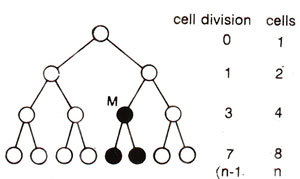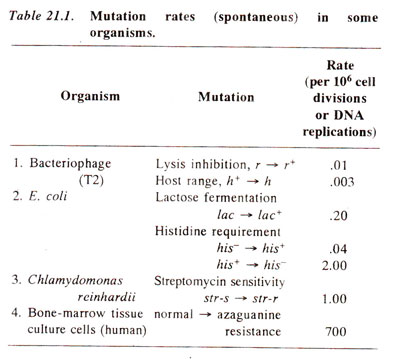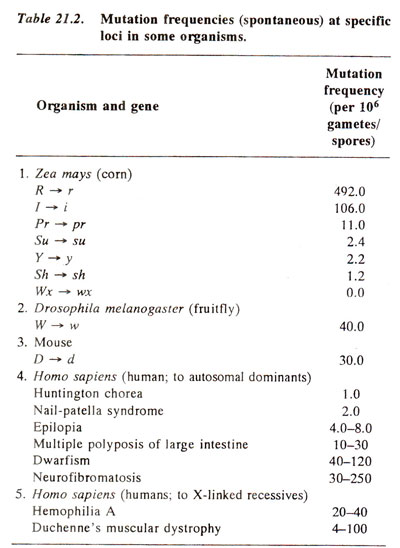Mutation Rates and Frequencies
A distinction between rates and frequencies of mutations has often been made. Whenever, such a distinction is made, mutation rates are described (at a locus or per genome) as probability of a mutation event at a locus (or mutation events at all loci in a genome) over a specific unit of time measured either as an organism generation or as a cell generation or as a cell division (not as hours or days). It is not easy to monitor and estimate cell divisions or cell generations. Therefore, more often we measure mutation frequencies, which are measured as number of mutants in a population of cells or individuals. The cell population can be gametes or spores. In Figure 21.2, the mutation rate is 1/7 per cell division, but mutation frequency is 2/8 = 1/4 per cell.
Mutation rates at individual loci
Mutation rates, per gene replication or per cell division could be measured in organisms like bacteriophages, bacteria or unicellular algae like Chlamydomonas, where from the number of mutant cells and normal cells, an estimation of number of cell divisions can be made. Some examples of these mutation rates are given in Table 21.1.
Mutation frequencies at individual loci
Mutation frequencies are more conveniently estimated and it has been shown that different genes in an organism differ in mutation frequencies. Some genes are unstable or mutable and thus mutate more frequently than others. L.J. Stadler used dominant marker stocks as male parents and crossed them with .female recessive stocks (e.g. cc ♂ x CC O) to estimate mutation (e.g. C → c) frequencies. Similar estimates of mutation frequencies were also made in fruit fly (Drosophila), mouse and human (Table 21.2).
Mutation frequency per genome
Mutation frequencies can also be expressed in terms of whole genome irrespective of genes involved. For instance, in Drosophila, an estimated number of genes is 5,000 and since average mutation frequency at a particular locus is one in 100,000, we should expect that one out of every 20 flies should have a mutation. In man, this frequency is perhaps higher.
Mutation rates, per gene replication or per cell division could be measured in organisms like bacteriophages, bacteria or unicellular algae like Chlamydomonas, where from the number of mutant cells and normal cells, an estimation of number of cell divisions can be made. Some examples of these mutation rates are given in Table 21.1.
Mutation frequencies are more conveniently estimated and it has been shown that different genes in an organism differ in mutation frequencies. Some genes are unstable or mutable and thus mutate more frequently than others. L.J. Stadler used dominant marker stocks as male parents and crossed them with .female recessive stocks (e.g. cc ♂ x CC O) to estimate mutation (e.g. C → c) frequencies. Similar estimates of mutation frequencies were also made in fruit fly (Drosophila), mouse and human (Table 21.2).
Mutation frequencies can also be expressed in terms of whole genome irrespective of genes involved. For instance, in Drosophila, an estimated number of genes is 5,000 and since average mutation frequency at a particular locus is one in 100,000, we should expect that one out of every 20 flies should have a mutation. In man, this frequency is perhaps higher.







